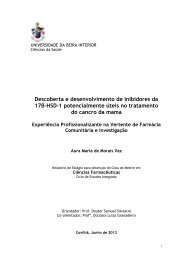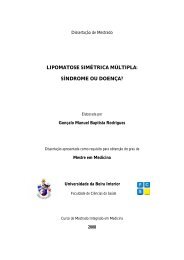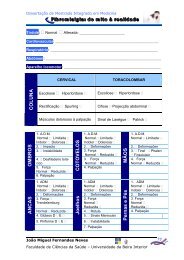prótese total do joelho – a história da arte: revisão bibliográfica
prótese total do joelho – a história da arte: revisão bibliográfica
prótese total do joelho – a história da arte: revisão bibliográfica
You also want an ePaper? Increase the reach of your titles
YUMPU automatically turns print PDFs into web optimized ePapers that Google loves.
A Prótese Total <strong>do</strong> Joelho: A História <strong>da</strong> Arte <strong>–</strong> Revisão Bibliográfica<br />
retináculos medial e lateral <strong>da</strong> rótula, que são expansões aponevróticas <strong>do</strong>s<br />
músculos vastos medial e lateral e <strong>da</strong> fáscia profun<strong>da</strong> suprajacente. Os<br />
retináculos sustentam a cápsula articular <strong>do</strong> <strong>joelho</strong>, lateralmente.<br />
O Ligamento colateral fibular (ligamento colateral lateral) é arre<strong>do</strong>n<strong>da</strong><strong>do</strong><br />
e em forma de cordão, sen<strong>do</strong> resistente. Estende-se inferiormente a partir <strong>do</strong><br />
epicôndilo lateral <strong>do</strong> fémur até à face lateral <strong>da</strong> cabeça <strong>da</strong> fíbula. O tendão <strong>do</strong><br />
músculo poplíteo passa profun<strong>do</strong> no ligamento colateral fibular, separan<strong>do</strong>-o <strong>do</strong><br />
menisco lateral. O tendão <strong>do</strong> músculo bíceps femoral também é dividi<strong>do</strong> em<br />
duas p<strong>arte</strong>s por este ligamento.<br />
O Ligamento colateral tibial (ligamento colateral medial) é uma faixa<br />
achata<strong>da</strong> forte, que se estende <strong>do</strong> epicôndilo medial <strong>do</strong> fémur até ao côndilo<br />
medial e p<strong>arte</strong> superior <strong>da</strong> face medial <strong>da</strong> tíbia. Neste ponto médio, as fibras<br />
profun<strong>da</strong>s <strong>do</strong> ligamento colateral tibial estão firmemente presas ao menisco<br />
medial. O ligamento colateral tibial, mais fraco <strong>do</strong> que o ligamento colateral<br />
fibular, é mais frequentemente <strong>da</strong>nifica<strong>do</strong>.<br />
O Ligamento poplíteo oblíquo é uma expansão <strong>do</strong> tendão <strong>do</strong> músculo<br />
semimebranáceo que reforça a cápsula fibrosa, posteriormente. O ligamento<br />
tem origem na zona posterior ao côndilo medial <strong>da</strong> tíbia e passa súpero-<br />
lateralmente para se fixar na p<strong>arte</strong> central <strong>da</strong> face posterior <strong>da</strong> cápsula fibrosa.<br />
O Ligamento poplíteo arquea<strong>do</strong> é, também, um reforço <strong>da</strong> cápsula<br />
fibrosa, posteriormente. Tem origem na face posterior <strong>da</strong> cabeça <strong>da</strong> fíbula,<br />
passa súpero-medialmente sobre o tendão <strong>do</strong> músculo poplíteo e espalha-se<br />
sobre a face posterior <strong>da</strong> articulação <strong>do</strong> <strong>joelho</strong>.<br />
Pedro Miguel Gonçalves Oliveira e Silva<br />
18








